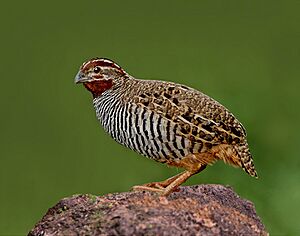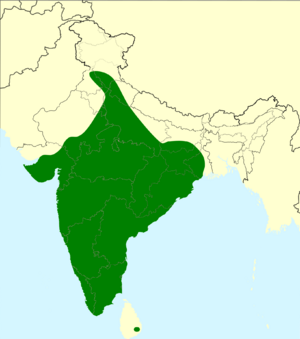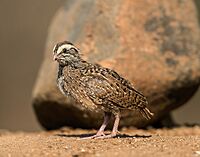Jungle bush quail facts for kids
Quick facts for kids Jungle bush quail |
|
|---|---|
 |
|
| Male | |
 |
|
| Female | |
| Conservation status | |
| Scientific classification | |
 |
|
| Synonyms | |
|
The jungle bush quail (Perdicula asiatica) is a small bird in the quail family. It lives in the Indian subcontinent, including peninsular India and Sri Lanka. It was also seen in Nepal a long time ago, but not recently. Some were brought to the island of Réunion and now live there.
These quails are small, about 15–18 cm (6–7 in) long and weighing 57–82 grams (2–3 oz). Males and females look quite different. Males have brown backs with black and buff markings. Their undersides are whitish with black stripes. Their faces are reddish-brown with a buffy-white stripe near their mouth. Females have a similar pattern but with pinkish-brown undersides and less colorful stripes.
Jungle bush quails live in dry areas with bushes or rocks. They eat seeds and small insects. They usually live in small groups of 6 to 25 birds. They start breeding when the rainy season ends and continue until the cold season finishes. They build nests in shallow dips on the ground and lay 4–8 eggs. Only the female sits on the eggs. The International Union for Conservation of Nature says the jungle bush quail is a "least concern" species. This means it is not in danger because there are many of them and they live in a large area.
Contents
About the Jungle Bush Quail
The jungle bush quail was first described in 1790 by John Latham. He called it Perdix asiatica. Later, in 1837, Brian Hodgson moved it to a new group called Perdicula. The name Perdicula means "small partridge" in Latin. The word asiatica means "from Asia".
The official common name for this bird is jungle bush quail. People also call it jungle quail or jungle bush-quail.
Types of Jungle Bush Quail
There are five known types, or subspecies, of the jungle bush quail:
- P. a. asiatica (Latham, 1790): This is the main type. It lives in northern and central India.
- P. a. vidali (Whistler & Kinnear, 1936): Found in southwest India. Its back is more reddish than the main type, especially on its head. Males have wider stripes on their undersides.
- P. a. ceylonensis (Whistler & Kinnear, 1936): This type lives in Sri Lanka. Its back and throat are much darker than other types.
- P. a. punjaubi (Whistler, 1939): Also known as the Punjab jungle bush quail. It lives in northwestern India. It is paler than the main type, with sandier backs and less clear black markings.
- P. a. vellorei (Abdulali & Reuben, 1965): Found in southern India.
What They Look Like
Jungle bush quails are small birds, about 15–18 cm (6–7 in) long. They weigh between 57–82 grams (2–3 oz).
Adult males have a dull brown back and wings with buff streaks and blackish-brown spots. Their chests and bellies are whitish with thin black stripes. Their lower belly is reddish-buff. The front of their head and above their eyes are dark reddish-brown. This stripe turns buffy-white behind the eye. The top of their head is dark reddish-brown with blackish-brown spots. Their cheeks are dark brown. Their chin and throat are also dark reddish-brown, separated by a buffy-white stripe near their mouth.
Males and females look different. Females have dull pinkish-brown undersides. Their wings have fewer stripes and spots. Their mouth stripes are also duller. Older females might have faint stripes on their chest. Young quails look like females, but they have whitish streaks on their head, throat, and chest. Young males get stripes on their undersides when they are about three months old.
The bill (beak) is blackish in adult males and dull brownish-grey in other quails. Their legs are pinkish to dull red, brightest in males. Their eyes are pale to orange-brown.
It's hard to confuse the jungle bush quail with other quails like Turnix or Coturnix. However, it might be mistaken for the rock bush quail. The rock bush quail's eye stripe is shorter and whiter, and its throat is reddish-white with a white stripe near its mouth.
How They Call
The jungle bush quail has a loud, rhythmic call that sounds like chee-chee-chuck, chee-chee-chuck. This call is similar to a black drongo's call when it's arguing.
When groups of quails get separated, they call out to find each other. They make a low, whistling sound like tiri-tiri-tiri or whi-whi-whi-whi-whi. Groups might also make gurgling or grating sounds that get faster. If they are scared, they make a low chuckle or harsh alarm calls.
Where They Live
The jungle bush quail lives in the Indian subcontinent. You can find them across peninsular India, north to Gujarat, Odisha, and the Kashmir foothills. They also live in Sri Lanka. They were reported in Nepal a long time ago but haven't been seen there since the 1800s.
They were brought to Réunion around 1850 and to Mauritius around 1860. However, they are now gone from Mauritius.
These quails like dry areas with bushes or rocks. They live in different places, from thin grasslands to thick deciduous forests. They are usually found up to 1,200 meters (3,900 ft) high. In some areas like the Western Ghats, they can be found up to 1,500 meters (4,900 ft) high. They usually don't move far from their homes.
What They Do
Jungle bush quails are often seen in groups of 6 to 25 birds. These groups are called coveys. They might be dust bathing on paths or looking for food in grasslands. Coveys walk along well-used paths to drink water in the morning and evening. They also make tunnel-like paths through tall grass.
These birds prefer to walk or run away from danger. They only fly as a last choice. If they get scared, the covey will hide at the bottom of a bush. Then, they will suddenly fly off in different directions. After a short time, they start running and gather back together by calling to each other. They sleep on the ground.
What They Eat
The jungle bush quail eats seeds from grass, weeds, gram, and millets. They also eat small insects, like termites and their young (larvae).
Reproduction and Life Cycle
The breeding season for the jungle bush quail starts when the rains end and lasts until the cold season is over. The exact timing changes depending on where they live. For example, it's from January to March in Karnataka and from October to March in the Deccan plateau.
These birds seem to have one partner for life. Their nests are shallow dips in the ground, lined with grass. They are usually hidden at the base of a bush. A group of eggs, called a clutch, can have 4–8 eggs, but usually has 5–6. The eggs are creamy white to pale buff. They measure about 24–28.4 mm (0.94–1.12 in) long and 18.4–22 mm (0.72–0.87 in) wide.
The eggs hatch in 16–18 days in the wild and 21–22 days in captivity. Only the female sits on the eggs to keep them warm. After the eggs hatch, the male helps protect and raise the chicks.
Conservation Status
The International Union for Conservation of Nature (IUCN) lists the jungle bush quail as a "least concern" species. This means it is not currently in danger of disappearing. This is because it lives in a very large area and its population is stable.
It is common throughout India. However, it is less common in Kerala and has disappeared from some parts of Gujarat and Uttara Kannada, Karnataka. In Sri Lanka, it was common until the 1950s, but now it is only found in certain areas in the hills of the Uva Province.
The introduced population on Réunion is decreasing but still common in some places. The population on Mauritius has died out. People in rural areas sometimes hunt the jungle bush quail for food.




